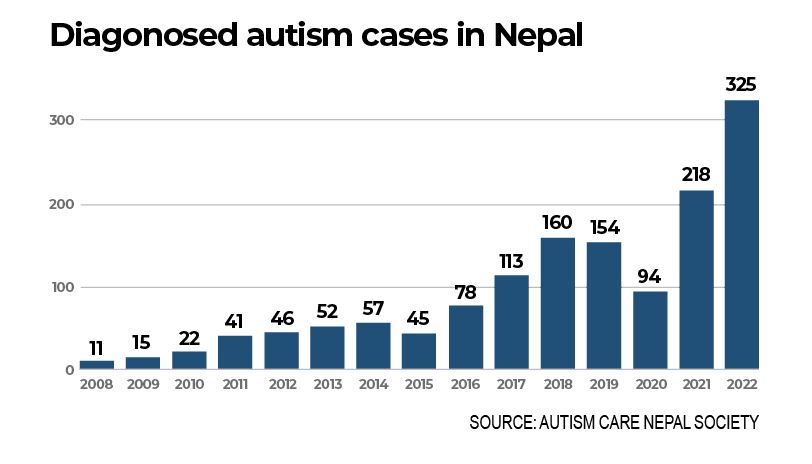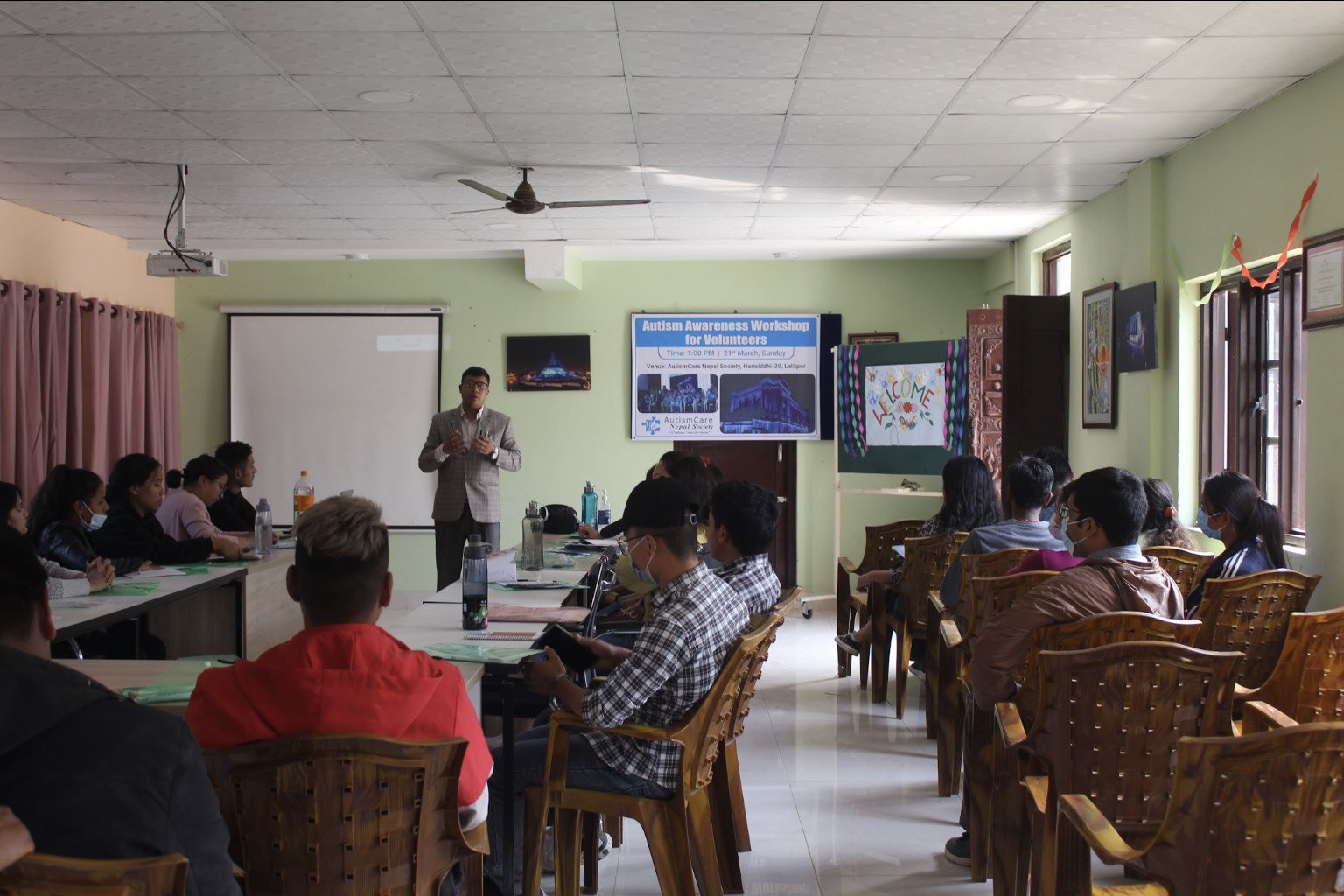Why are autism cases rising in Nepal?
A worrying increase in autism among younger Nepalis means more support for patients and caregiversIn 2014, when Surendra Bajracharya was conducting an autism screening camp in Doti, he came across the most unusual case he had seen till then and since. A 46-year-old man had been carried by his brother in a doko basket on his back all the way from his home in the village.
The patient had spent his childhood tied up on a leash due to his impulsive behaviour, unusual mood reaction and fits. He had never learnt to move on his own.
“He could not speak or walk. We first thought he had cerebral palsy,” recalls Bajracharya. “But after examining him we felt his symptoms matched those of people with autism.”
Read also: A for autism, Sulaiman Daud and Cindrey Liu
The patient and his brother were orphaned at a young age, and it was the brother who was his guardian and nurse all his life. There was no other support system in the family or community.
As the office head of Autism Care Nepal Society (ACNS), Surendra Bajracharya has seen everything from a parent dying by suicide due to being overwhelmed by his autistic child to children being caged in attics and enduring social ostracisation because of their condition.
But of late, there has been growing awareness in Nepal about autism. In the last decade, ACNS has seen a steady rise in the total diagnoses from just 11 in 2008 to over 300 in 2022. This does not necessarily mean an increase in incidence, but is a good indicator of greater awareness and concern about autism among parents and the public.
Read also: A care in time, Paavan Mathema

However, the increase in cases of autism has also been linked to unhealthy dietary practices, especially junk food by the mother during pregnancy.
Following the Covid-19 pandemic, doctors are also reporting an unusually high number of children with what they call ‘virtual autism’. Excessive screen time before two years of age, they believe, is associated with a decrease in cognitive and language development.
“We have enough reason to believe that virtual screen time is the primary catalyst for this drastic rise in cases,” states Bajracharya. “They grew up confined in their homes, overexposed to screens and away from social interactions during the pandemic.”
According to the World Health Organisation (WHO) estimates, 1 in every 100 children globally has autism. Nepal's 2021 Census reported 4,886 individuals with autism out of 647,744 people surveyed, which is 0.8% of the sample population.
“Although recognising autism as a disability in the National Census was a first for Nepal, the actual prevalence of autism spectrum disorders is higher than reported,” adds Bajracharya. “And it is likely that increasing screen time will further worsen the problem in children.”
In 2019, the ACNS estimated that there were some 300,000 children living with autism in Nepal. More credible data is crucial for Nepal to base its interventions and policies on autism care.

At the Centre for Autism in Kathmandu, parents are increasingly aware of the special needs of their children, but lack adequate service and support.
“There is no incentive for autism caregivers in Nepal,” says Manju Shrestha, an autism specialist at the centre.
When Shrestha joined the centre two years ago, there were 32 children enrolled. In two years, that number has almost tripled to 92, with many mildly autistic children progressing into mainstream schools after substantial improvement.
“Most parents approach us with concern about their toddler’s delayed speech,” explains Shrestha. Among other symptoms, delayed language development, hyperactivity, restricted behaviour, repeating words and phrases over and over, or playing with the same toys the same way every time are the most common signs that parents have started correctly identifying on their own.
But despite such strides in public awareness due to the Internet and social media, the government has been slow to act.
The Disability Act 2074 has classified disability into four categories on the basis of severity: namely profound (A), severe (B), moderate (C) and mild (D). Individuals in each group get assigned a different coloured identity card with which they can access different levels of care and privileges.
But with autism, children often do not get assigned the correct card. “Although an autistic child may need the same level of care as someone with leprosy, they are only assigned category B, while those with physical disabilities are assigned group A,” explains Shrestha.
Such misplaced categorisation means the child’s family receives a lower allowance which falls short of helping them afford necessary therapy.
“The problem lies in the difference between autism and other physical disabilities,” argues Shrestha. “To most people children with autism may look completely normal. They may even utter a few words, occasionally respond, and seem just like any other child. But the psychological and emotional care they need is significantly different.”
Autism Care Nepal Society and Centre for Autism are two of only a handful of special needs schools that understand this difference. They employ autism-friendly teaching and learning methods tailored to the needs of each individual child, helping them progress at their own pace.

On a national level, the availability of such institutions, therapists and specialists is inadequate. To bridge this gap between the rising cases and insufficient specialists, ACNS has been running a diploma in special education in autism spectrum disorder.
ACNS also conducts several awareness and training projects across Nepal, including a parent-child training project that has seen widespread success in 44 districts across all seven provinces.
Plans are underway to set up a new National Centre for Autism in Lalitpur to provide education, training and other services to individuals and families affected by autism. ACNS hopes to work with the Ministry of Education, Ministry of Health and Ministry of Women, Children and Social Welfare to diversify and decentralise autism care.
While much of the ignorance and taboos associated with autism are dissipating with increased knowledge and awareness, the condition remains a public health concern in Nepal. The cases are going up and those afflicted are increasingly younger.
Experts say the government has to abandon its one-size-fits-all approach in dealing with autism spectrum disorders. For a health issue as wide-ranging and variable as this, care must also be provided to meet diverse needs.
Says Manju Shrestha: “Recognising the abilities, talents and sparks within each child with autism demands drastic shifts in our present state of healthcare and education. This change is long overdue.”
As for Surendra Bajracharya, the middle aged man he met in Doti nine years ago is still etched in his mind, and it inspires him to do more. He says, “The innocence in his eyes … it is tragic that people have to suffer so much from an affliction when care can be made available.”




